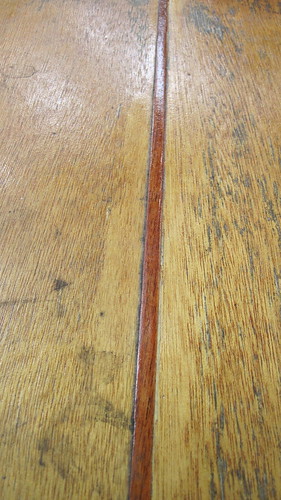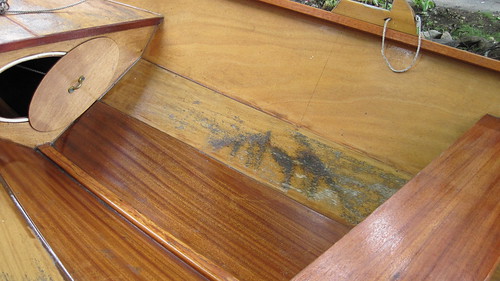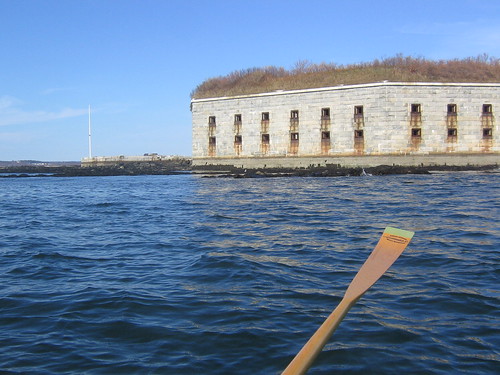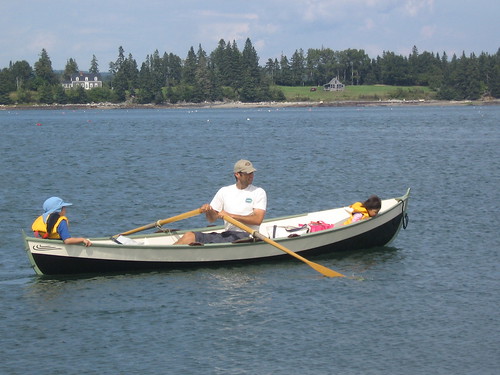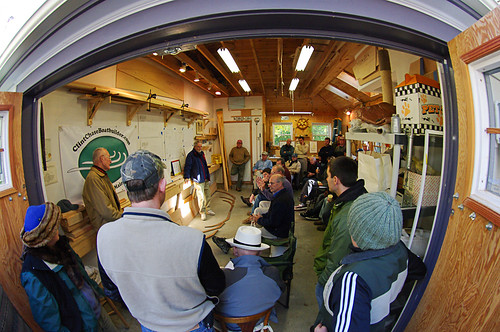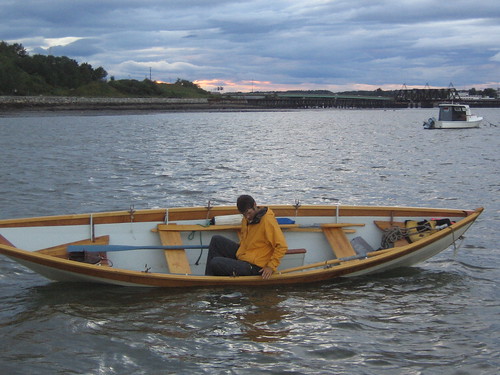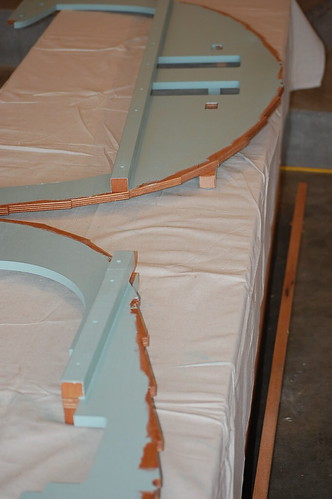
Selasa, 21 Desember 2010
Epoxy Encapsulation & Prefinishing in Montana!

Kamis, 02 Desember 2010
Quality Plywood & Epoxy Encapsulation
Rabu, 24 November 2010
Top 5 Thanksgivings at Clint Chase Boatbuilder
#1: The new shop. The goal by the time we were sitting down for turkey was to be in the new shop and pretty well set up so we could get back to customers' projects with as little delay as possible. We are a few days off the goat but still pretty darn thankful for this 1100 SF space where we'll be able to build above 30' or have multiple smaller boats in construction, or new construction and a prototype, or one big boat, mastmaking, and oarmaking all happening under one roof for the first time.

#2: Our customers. We wouldn't be here without them. A handful now are out there building our boats around the States, from Maine to Washington, Montana to Texas. Thanks to those who have helped me start out and who help me keep on!
#3: The designers we contract with have been key to our success and I thank all of them: Francois Vivier, Michael Storer, Bruce Elfstrom, Eric Risch, Ruud Van Veelen, Rodger Swanson, Roger Long, and all those who have helped contribute to our grand plan.
Minggu, 07 November 2010
Dories get some attention!
Sabtu, 16 Oktober 2010
The Perfect Rowboat, Sailboat, or Both?
Selasa, 12 Oktober 2010
Invitation to Fall Shop Talk & Messabout in Portland, Maine


Please join me for the 2nd annual � �It�s a tradition now� � shop talk and messabout. This year we�ll welcome our guest designer/builder Walter Wales. Also with him will be WoodenBoat�s Associate Editor Karen Wales (Walter�s wife) and renowned illustrator Sam Manning and his wife Susan.
Walter is an acknowledged expert on the Marblehead Gunning Dory originally built by Will Chamberlain of
Walter and Karen will bring their Gunning Dory REPUBLICAN, built in 1960 by Capt Gerald Smith from Will Chamberlain�s molds.
Walter and Sam will talk about the history, design, construction, and use of this famous dory type. In addition to REPUBLICAN we�ll have a couple other dories on site to look at and discuss.
Bring a boat because afterward we�ll head to
WHAT: 2nd Annual Shop Talk & Messabout
WHERE:
MAP: http://tinyurl.com/ClintShop
CCBB Blog ClintChaseBoatbuilder.blogspot.com
Kamis, 23 September 2010
New Francois Vivier designed Yawl with Clint Chase

 Francois Vivier and Clint Chase are busy designing a new dayboat/weekender. This has been a fun collaboration and we have a lot more work to do. By this time next year, it is planned that we will be building this boat in our shop for our family use and for showing in 2012. Francois's boats are designed with a CAD-CAM approach, meaning the drawings are done in the computer, files are generated, and these files can be used to do CNC cutting of all the drawn boat parts, such as bulkheads, molds, and planking. Some of the design requirements were:
Francois Vivier and Clint Chase are busy designing a new dayboat/weekender. This has been a fun collaboration and we have a lot more work to do. By this time next year, it is planned that we will be building this boat in our shop for our family use and for showing in 2012. Francois's boats are designed with a CAD-CAM approach, meaning the drawings are done in the computer, files are generated, and these files can be used to do CNC cutting of all the drawn boat parts, such as bulkheads, molds, and planking. Some of the design requirements were:� To be trailerable by an ordinary car, and therefore light, and be able to beach temporarily for loading/unloading.
� To have a large, wide and deep cockpit, comfortable, allowing for fishing and a place where children could be safe.
� To have a stable hull for family sailing but give excellent performance for weekend sails �with the guys�.
� To have a cuddy cabin, with a toilet for women and children, a small galley to heat some meals and two berths to spend a night or two on board, or for napping.
What I am most excited about is getting my kids out sailing again.
Selasa, 14 September 2010
Free Goat Island Skiff Yawl Plan

Selasa, 07 September 2010
Day Three in Drake: The final day of the Small Reach Regatta

The final day was going to have big shoes to fill after an incredible reach and row day 2. The rowing group gathered at breakfast to scheme a separate rowing group to explore along MDI's north coast and down to Bar Harbor. We did just that with the generous support of the chase fleet whose member take very seriously there job to watch everyone, help us stay safe, and get us out of trouble when we need it. The sailing fleet (most of the boats) went to Bean Island just east of Hancock Point and the rowing group (5 boats) went south to Bar Island on an absolutely windless morning and a fast outgoing tide. After lunch on Bar, we had a rolicking return as the seabreeze turned on and was blowing a steady 15 kts. Drake shone again as we surfed down the white-capped, following sea. I had left the sailing rig ashore to be a pure rowboat today. The timing was perfect on the way back into Lamoine Harbor area: the entire sailing fleet was also returning. After a little racing in the rowboats, we coalesced into a parade of sails past the state park where onlookers marveled at the sight reminiscent of the age of sail when it was commonplace to see so many sails filling a waterfront view.
Senin, 06 September 2010
Small Reach Regatta: Day 2 in Drake Rowboat

Sabtu, 04 September 2010
Drake in the Small Reach Regatta on the Coast of Maine: Day 1

The event was three days. Day 1 was a short windy upwind row and downwind return to a classic small Maine coast island. Every day features an interesting lunch stop, a wonderful opportunity to rest and to look at others' boats. Moreover, I see it as a learning experience to talk to the builders and owners of the boats. I learn something new from every one of the boats. For me, the SRR is about the finest form of professional development I can get.
On the downwind return to camp, a small squall came through and the force overcame my mast step..."WHAM!"...I heard the snap and the boat lurched and we nearly capsized. The first night was a quick repair with polyurethane glue while the sun set. Day two was to feature a long, fast broad reach to the lunch spot, and there was no way I was going to miss sailing that stretch! I was repairing until I couldn't see anymore boat...will it work?
Kamis, 02 September 2010
Teaching at The Wooden Boat School: Tradional & Modern Oar Making
We were able to get out for two solid rows where CLint coached some fixed seat rowing and we all just enjoyed learning how to use oars and be comfortable in rowboats. We were able to use the school's fleet of rowboats, including this Joel White Shearwater.
Students quickly learned that oar making is mostly a wood removal activity, but they also learned some of my tricks, like adding decorative laminations on the outside of the upper looms. They also learned that there is a bit of engineering and art in making oars. Because we were able to get on the water, we also so the clear link between how we shape oars in the shop and how they react on the water.
Finishing oars after sanding is as much work as shaping them. One of my big pet-peeves is that oars are balanced and we spent a couple hours balancing everybody's oars with a little lead in the handle. It does not make the oar heavier, effectively, because the oar's weight is on the gunwale. Therefore, it is the balance that makes oars feel lightweight. Leathering the oars is a project as well as sealing and varnishing. Everybody left with the oars largely done. One student had a good challenge. He brought in a pair of hollow sculling oars and wanted to make a replacement (or back up) pair in a week. So, we made the loom solid, sized down, and laminated a pair or plywood blades much like I do in my shop for customer's oars, over a laminating jig. The blades are glued on the shaped loom and the finished result looks like this, and I might add he is very happy with them. In fact they are no heavier than the original, hollow sculls!
Selasa, 31 Agustus 2010
Mast making at Shaw and Tenney
The masts were all cut, rounded, and sanded by hand. They weight a few hundred pounds in the rough and were a challenge to put through the planer. Their dimensions had to be very accurate. Like any mast, once the piece is 4-sided and tapered, we can start 8-siding as we are doing above with a small skilsaw. After 8-siding this way, the mast was brought to 128-siding with nothing but patience and my favorite power planer. After two days plus of the power planer, when I that machine down for good, I can recall my hand vibrating for several hours.
The final rounding was done with custom shaped foam blocks, a trick from boat school that I use on a lot of projects. This was followed by finish sanding with the Festool. The result was some very nice masts! It was a wonderful place to work and watch the masters do their trade. One of the guys has been making oars and paddles for 25 years. To watch him work was quite impressive. I look forward to doing more business with S & T. Recently, they chose Clint Chase Boatbuilder as their official builder of their beautiful Whitehall.
After this project it was back to Portland for an overnight to see the family and pack for the next iconic week: Wooden Boat in Brooklin, Maine. I was to make my teaching debut at the Wooden Boat School.
Jumat, 27 Agustus 2010
Wooden Boat Show Family Boat building
They launched on the third day at 3pm. They were very proud and perhaps glad they had a break to enjoy their success. My former life was a teacher and instructing people to build their own boats. Getting new folks into small boats, building their own boats from kits, and experiencing success in everyway is the number one priority for our customers. Likewise, we felt this year's Family Boatbuilding was a success and will plan to do these boats again next year.
Senin, 21 Juni 2010
Birdsmouth Sparmaking Demo

Clint will be giving a hands-on demonstration of Birdsmouth sparmaking at the Wooden Boat Show at 1pm on this coming Sunday. Please come by. The show starts Friday in Mystic, CT.
See more at http://www.clintchaseboatbuilder.com/Birdsmouth.html
Jumat, 28 Mei 2010
A new rig for a Goat Island Skiff, Spruce for Roger Long's Yawl Dory and more Birdsmouth Masts and Spars
To find good spruce you need to go right to the source. I enjoyed some wonderful walking with a customer who is having a Yawldory by Roger Long, N.A., built and wanted the Spruce for the spars, masts, and oars (my job) to come from her friend's land. We walked (i.e., bushwacked) and tagged a few nice Spruce trees.
Birdsmouth Masts under construction for a Michael Storer Goat Island Skiff. With Michael's blessing, Clint drew a yawl rig for the boat.
Varnishing the Sitka Spruce/Northern White Spruce Birdsmouth mast allows the grain of the Sitka to deepen and develop the contrasting lighter-colored Northern White Spruce. You get some of the benefits of Sitka for half the cost by mixing it with the local spruce we get hear in Maine and Canada.
Kamis, 06 Mei 2010
CNC Boat Kit Cutting at Harbor Sales; First Three Francois Vivier Kits Sell
Last week, Clint took a trip to Maryland where Harbor Sales is located and cuts our CNC boat kits. The goal was to oversee the cutting of three Vivier kits that sold, Youkoulili, Ebihen 16, and Beg-meil. Harbor imports the plywood and cuts the panels on any of their four CNC machines (one of which has a 10x23 capacity and the one pictured is a 5x12). They package and ship by UPS Freight the kits direct to the customer. Clint sends the building instructions and getting started materials from Maine. Francois send the plans from France. We get epoxy starter kits to customers from Duckworks in TX or System Three Epoxy in WA.
One of the special features of Clint's kits is visible in the close-up shot of the machine cutting the planks. You may be able to make out the 'NC scarf' being machined onto the end of the plank. These scarfs are snapped together and glued by the builder and fits such that the pre-cut spile and sweep of the planks are maintained and perfectly aligned. Hours were spent making this critical feature work perfectly.
Cutting starts in a room full of computers. The files are opened, modified and sent to the machine outside of the room. The cutter exits to a console next to the machine, calls up the file and commands the machine to do its thing. The machine moves fast and there is an automatic shut-off sensor in case you step too close.
Also in kit building news, the Drake Rowboat, winner of the Wooden Boat Show Concourse De Elegance in 2009, is on the bench as a 1/4 scale CNC model. This step always comes before cutting an actual full size CNC model which is test built and checked again and again to adjust the files until they cut perfect molds, planks, laminating jigs and whatever the kit components are for that design.



